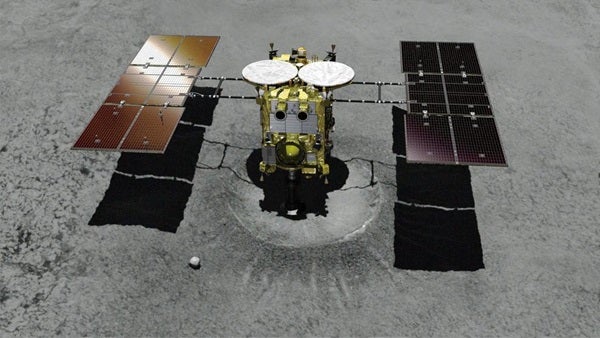Hayabusa2’s encounters with asteroid Ryugu have been delightfully action-packed. In February, the Japanese spacecraft collected its first sample by swooping close and firing a bullet into the asteroid’s surface to stir up material it then snagged with a horn-shaped collector. Then, in April, it shot a much larger impactor into Ryugu, creating an artificial crater so it could examine the material churned up from beneath the surface. On Thursday, Hayabusa2 returned to the scene of the crime and fired a second bullet, collecting material from its newly made crater.
Astronomers hadn’t been certain they’d be able to find a safe spot to touch down in the new crater, and spent the last few months scouting the area and analyzing the images Hayabusa2 sent back. The successful collection of this second sample means the mission has accomplished all its major goals, and can head back to Earth later this year on a positive note.
A rocky journey
Hayabusa2 is just one spacecraft currently surveying an asteroid with the goal of bringing back pieces of its rocky partner. A NASA mission called OSIRIS-REx is similarly investigating the asteroid Bennu. Astronomers often find fragments of asteroids in the form of meteorites that fall to Earth, but obtaining samples directly from space gives them a clearer picture of where and how these space rocks formed and how they’ve spent the past few billion years of solar system history.
The mission team behind Hayabusa2 has had to work hard to get their spacecraft to finish the job it started when it launched back in 2014. Its asteroid, Ryugu, proved more jagged and rocky than mission planners had anticipated. The spacecraft must descend all the way to the surface to collect its samples, and it’s not built to handle rough or uneven terrain. The engineering team found that to guarantee a safe touchdown, they had to dramatically increase the accuracy of their touchdown targeting.
That took longer than they’d planned, and the craft has a schedule to keep. Its mission timeline has it leaving Ryugu in December so it can bring its samples back to Earth for study. It’s also a race against time, as Ryugu’s surface is about to become too warm for Hayabusa2 to handle, meaning it couldn’t just extend its stay indefinitely.
But the engineering team persevered, and Hayabusa2 has now successfully completed all its main mission objectives. It still has a few months of work left to do in orbit around Ryugu, taking pictures and measurements from afar, before it can return to Earth with its prized samples.
If you want to re-live the whole encounter, JAXA has posted their livestream online.










